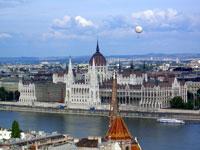 Budapest OverviewBudapest, known as the 'Queen of the Danube', is a magnificent
city exuding a cultural sophistication that entices and enchants.
Gracing both sides of the legendary river with grand historic
buildings, regal bridges and graceful tree-lined boulevards, it is
the city's elegant beauty and romantic atmosphere that has given
Budapest Parisian status among the Eastern European countries. Budapest offers the visitor the familiarity of European culture
with a distinct Hungarian flavour. It is evident in the neo-Gothic
Parliament buildings, sidewalk cafes and Magyar cuisine; classical
concerts and Hungarian folk music; the cobbled streets of medieval
neighbourhoods and shady parks, and everywhere the sounds of an
unfamiliar language. Highlights for visitors include a river cruise
on the Danube and a thermal bath in one of the Turkish-era
bathhouses. Budapest was originally two cities built on either side of the
Danube, namely Buda and Pest. The two districts are still distinct
in their contrasting makeup, with the older and more charming Buda
comprising of atmospheric cobbled streets, little picturesque
coloured houses and a medieval, neo-Classical mixture of
architecture set among the gentle hills of the west bank. It is
famous for its historic Castle Hill featuring the Royal Palace,
museums and galleries, St Matthias Church and the ramparts of
Fisherman's Bastion. Pest lies on a flat plain and is the commercial core of the
city. It bustles with fashionable shopping areas and has
characteristically wide, leafy boulevards. Andrássy Boulevard is
the Champs-Elysées of Budapest, lined with a typical mosaic of
architectural styles and buildings with the enormous Heroes' Square
at the end. A history of numerous wars and invasions, with repeated
destruction and rebuilding, has created the Budapest of today, with
an amalgamation of styles, created over time during periods of
loving restoration by a proud and resilient nation of people; a
city of charm and character, both European and singularly
Hungarian. |